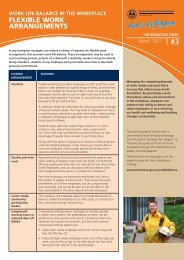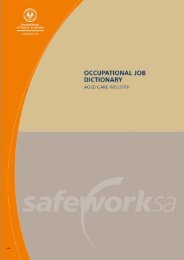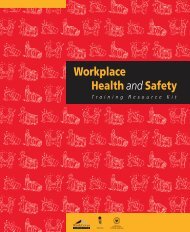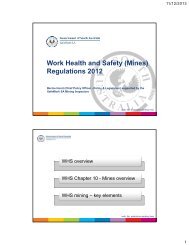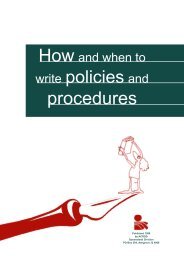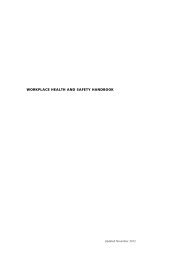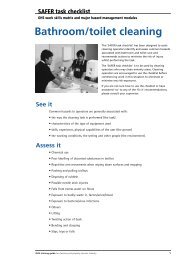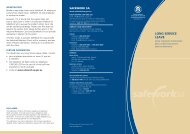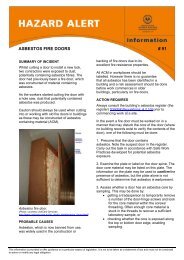Hospitality Industry Occupational Job Dictionary ... - SafeWork SA
Hospitality Industry Occupational Job Dictionary ... - SafeWork SA
Hospitality Industry Occupational Job Dictionary ... - SafeWork SA
You also want an ePaper? Increase the reach of your titles
YUMPU automatically turns print PDFs into web optimized ePapers that Google loves.
RECOMMENDATIONS<br />
BANQUETS/FUNCTION STAFF - CASUAL (Large venues)<br />
1. Dance floor trolleys and stage trolleys should be acquired for transport to be pushed/pulled with two-person<br />
teams at all times. This task is conducted with one or two workers and is in the heavy work category. Ideally,<br />
push/pull forces should be less than 5kg, to minimise cumulative trauma to the upper limb girdle.<br />
2. It is preferable that larger tables and trestles that are to be regularly moved are on castors and folding so that<br />
they can be transported with minimal lifting requirements using minimal push/pull forces and thus reducing<br />
strain on the upper and lower limb girdles.<br />
3. Workers may benefit from rotating tasks of serving, setting tables or drink service, at least every day to avoid<br />
overuse of their dominant upper limb, or development of non-dominant upper limb static muscle loading<br />
problems due to static elbow flexion required to hold tray etc. Workers may also benefit from rotating holding<br />
trays/plates in opposite upper limb to avoid overuse or cumulative trauma.<br />
4. Uncarpeted ramps may require non-slip surfaces to be sprayed, to avoid any possible slipping when working<br />
or pushing trolleys up or down.<br />
5. Workers may benefit from the use of correct work postures. Back care education and lifting/handling principles<br />
could be reinforced via on-site education sessions:<br />
a) lifting to be conducted with feet at least shoulder width apart<br />
b) carry, push/pull be conducted with load as close to the body as possible, with neutral shoulders and<br />
semi-flexed elbows<br />
c) workers to complete correct foot work for push/pull or lifting including feet facing in direction of movement<br />
d) lifting to be conducted with squat postures, to avoid back stooping.<br />
6. Pre-employment evaluations may be beneficial for all new employees to ensure potential employees have<br />
the physical capacities to meet the physical demands of the job.<br />
7. A diagram of a correct computer work station set up has been included on page 174. Essential features include:<br />
a) correct seated posture with ankles, knees and hips at 90º of flexion, with the lumbar curve supported<br />
by the tilting backrest<br />
b) a footrest may be required to support this correct posture, depending on the height of the operator<br />
c) when keyboarding, shoulders should be in a neutral position with elbows bent to 90º<br />
d) monitors should be adjusted approximately one arm’s length away, with the top of the screen at eye level<br />
e) frequently used items such as mouse pad, telephone, pens, pencils etc should be placed as close to the<br />
work station as possible to avoid excessive stooping and over-reaching.<br />
8. A document holder may be beneficial for computer work tasks. This is a clear perspex adjustable tilt document<br />
holder, which allows documents to be placed over keyboard for workers to maintain minimal lateral neck flexion<br />
to view documents on table. Alternatively, an ergo tilt document holder may be beneficial to place documents<br />
on behind keyboard. Depending on desk space available a keyboard trolley tray to place keyboard under desk<br />
would allow for the document holder to be placed on desk.<br />
9. It may be beneficial to place the computer monitor on a telescopic platform, to assist in adjusting height<br />
for workers to maintain computer at eye level. Platforms are available from office equipment suppliers.<br />
10. Pause exercise breaks are essential to minimise static muscle loading, especially for food/drinks service.<br />
11. Vertical handles for trolleys are preferred to allow neutral forearm position, to minimise strain on the wrist.<br />
The current horizontal handle locations lead to fully pronated forearms.<br />
12. Workers to use trolleys/equipment and a two-person team to move tables and chairs to reduce lifting requirements.<br />
OCCUPATIONAL JOB DICTIONARY - HOSPITALITY INDUSTRY - HOTELS AND MOTELS 71



